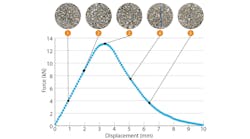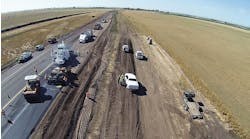Gilbert Central has had many paving successes in Arkansas in the past few years. The company’s awards—and bonuses—prove it. “We obtain smoothness bonuses on every project that has an incentive program,” said Chris Loeffler, a project manager with Gilbert Central, Little Rock, Ark. “It is our goal to achieve a minimum of 90% of the total achievable incentive.”
The company invariably reaches its goal. On the last three projects it achieved 98%, 93% and 95% of incentives. The I-30 project at Gurdon, Ark., won the Statewide Multi-Lane Pavement Award for Quality from the Arkansas State Highway and Transportation Department and the Arkansas Asphalt Pavement Association. In addition, this year’s I-40 project at Conway, Ark., achieved 98% of the available incentive and had a profile index average of less than 1 over 40 lane-miles of interstate. That work has been nominated for a National Asphalt Pavement Association award. The accolades make it clear that Gilbert Central, a division of Peter Kiewit Sons Inc., is committed to surpassing smoothness specs. But how, specifically, does the company do it? Loeffler said the following are the keys to the firm’s successes:
Training
Gilbert Central sends key members of its paving teams to Paving Operations Training, conducted through Caterpillar. The training is an investment that pays off, Loeffler said.
“That training has a direct impact on our ability to meet smoothness specs.”
Gilbert Central crews took pride in their knowledge before the training, but even seasoned veterans were surprised by how much they learned. “Our comprehension after the training was at least double what it had been before the training,” Loeffler said.
A key lesson is that proper setup of the paver is crucial to laying a smooth mat—as well as other elements of production.
“After the training, the crews were able to maximize the potential of the paving equipment, particularly regarding grade and slope,” Loeffler said. “There was an increased emphasis on automatic grade and slope settings. The crews learned what all the bells and whistles were, and they understand what the codes mean on grade and slope. Now they can interpret them and make adjustments.”
That knowledge was crucial given federal standards, particularly new codes for superelevated curves. Some curves required a slope of 9% in areas that previously had a 1.5% slope. But the elevated curve meant the thickness of the initial lift varied greatly from one side to the next. “One end of the paver is putting down substantially more mix than the other,” Loeffler said. “That requires a good paver. But you also have to know how to use it.”
That process would have been much more difficult without the training, according to Loeffler. “You’re paving grade and you’re paving thickness,” he said. “Both of these have to equate to smoothness.”
Continuous paving
Loeffler said a material transfer device (MTD) helps Gilbert Central achieve its smoothness goals. “The key to smoothness is consistent speed.”
The MTD allows crew members to match paving speed with plant production. In addition, the MTD re-mixes the asphalt while transporting it to the hopper, which helps prevent segregation.
Loeffler considered proper maintenance practices to be part of continuous paving. Gilbert Central uses an off-season maintenance plan that essentially strips the paver down in a search for wearing parts.
“Crews do visual checks daily during the season but there obviously are some things you need to take a closer look at,” he said. “The time to do that is during scheduled down time, not because a crisis pops up. With the maintenance plan, we do the checks on our schedule.”
Mix cools during unscheduled down time. Those issues can lead to temperature variations that affect compaction. Smoothness problems can result.
The ski
Gilbert Central uses a 55-ft ski as its averaging device. The ski permits an average to be taken from the grade surface and another from the freshly laid mat. These averages are combined and measured at the grade sensor near the screed tow point. This allows a mean average to be obtained over the entire span.
“The ski can sense and correct for any change in screed elevation brought about by an inconsistent material head,” Loeffler said. “The ski is a crucial part of mat smoothness.”
Commitment to quality
Gilbert Central managers constantly talk about quality, and they show their commitment, too.
That in part is accomplished through the purchase of quality equipment and sending crew members to the Paving Operations Training program. “Our leadership shows they’re willing to invest the money to achieve the desired results,” Loeffler said. The crews carry on that tradition. Adding incentive are the bonuses paid for smoothness. “We share the bonuses,” Loeffler said. “The crews know what they need to do, and they get it done. It’s only fair that they get a portion of the money because they have to deliver the results.”
Gilbert Central also believes in addressing quality issues immediately. “We make every lift count,” Loeffler said. “We pay as much attention to the first lift as the surface lift.”
Problems with an initial lift can adversely affect the end product.
“We never say, ‘We’ll fix it later,’” Loeffler said. “That’s an attitude we just can’t afford.”
Not if the company wants to continue winning awards—and bonuses—as expected. “We plan to continue to improve,” Loeffler added. “We’re committed across the organization to doing exactly that.”


